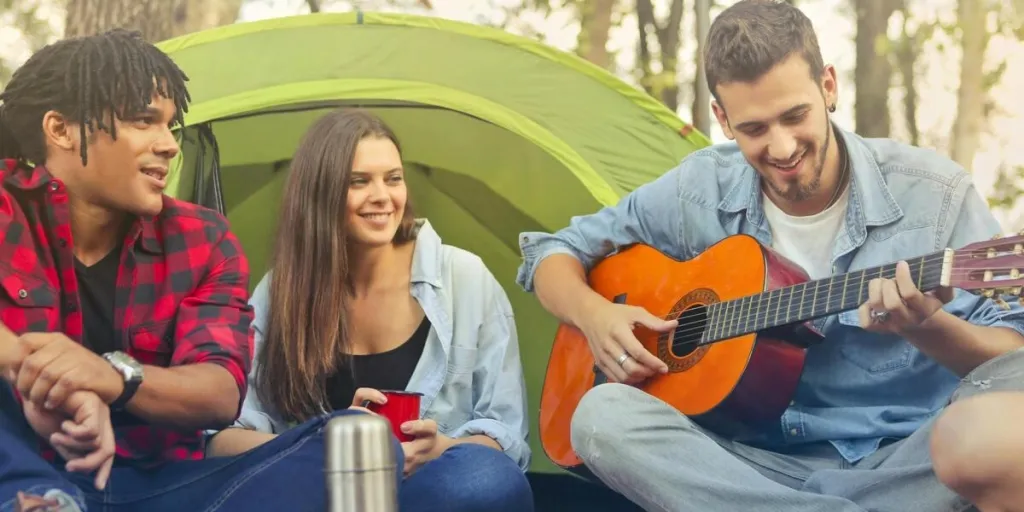Camping is an exciting way to get people close to nature. Reports show more and more people are going camping these days. A 2019 study found that 1.4 million more people in the U.S. started camping, bringing the total to 78.8 million campers. Australia saw a similar increase, with 5% more people staying overnight in caravans and campsites that year. People go camping for all sorts of reasons. Some want adventures, while others like it because it’s a cheap way to live.
Setting up a camping tent the right way can make trips more fun and, of course, comfortable. This blog post explores some key tips and tricks to ensure retailers can confidenently guide their buyers through an enjoyable camping experience.
Table of Contents
Camping tent market overview
What to bring with you when camping
Setting up a tent for camping
Tips for a successful camping experience
Wrapping up
Camping tent market overview
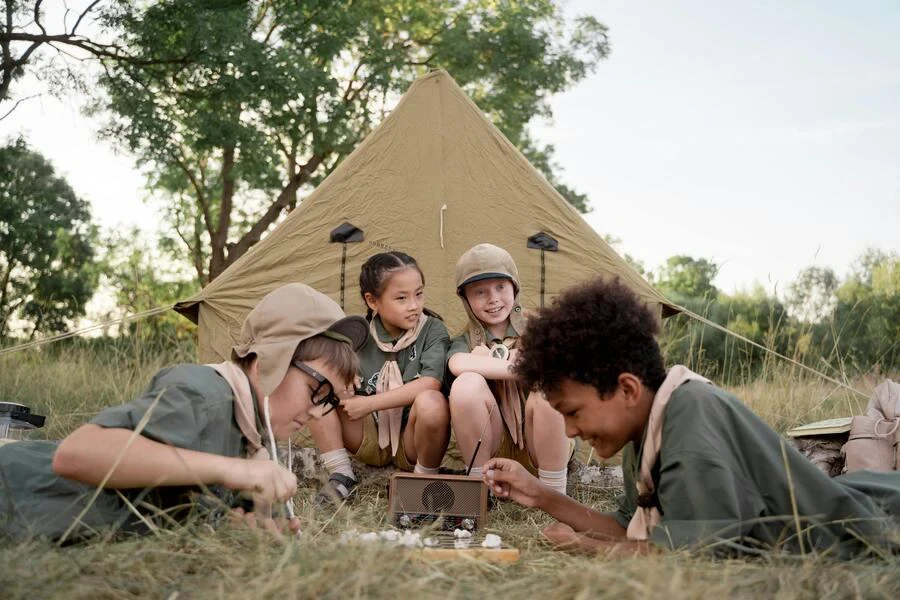
The global camping tent market generated approximately US$ 3 billion in 2023. It is projected to reach US$ 5.1 billion by 2031, growing at a compound annual growth rate (CAGR) of 5.1% between 2024 and 2031. Europe dominates the market for camping tents due to the increased participation in outdoor activities throughout the region. It has multiple outdoor recreational facilities, national parks, and campsites, encouraging people to embrace camping.
There are multiple factors driving the camping tent market growth, including increased availability of tents through online and offline channels, higher disposable incomes among consumers, advancements in tent design, and access to extensive products that cater to campers’ needs.
What to bring with you when camping
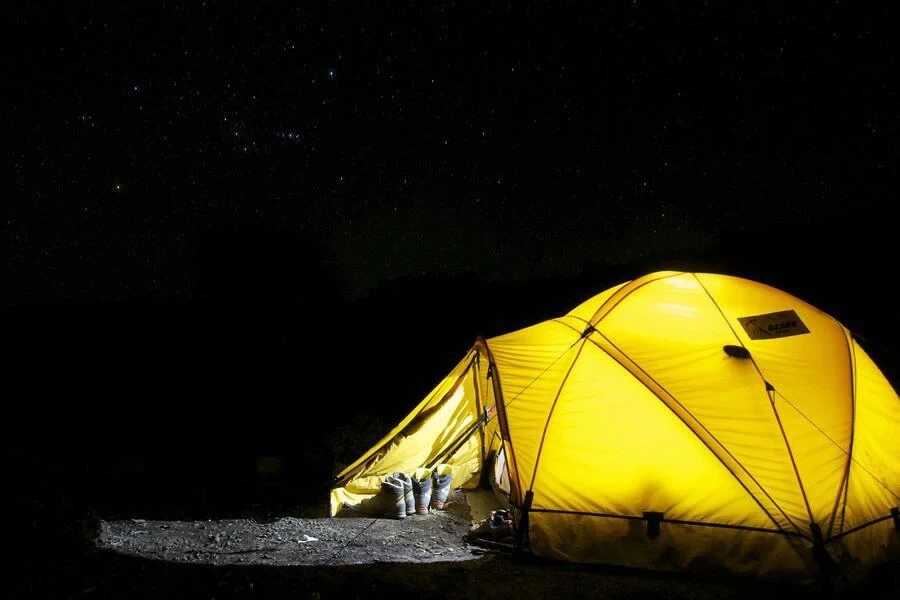
Campers need a number of things to have the best time outdoors. As someone who runs a business, knowing what they need helps you make your products and services better. This leads to happier customers who will be more likely to come back, giving you a competitive edge over your competitors.
Some key items on the the checklist for enjoyable camping are:
Must-have gear
Before they leave, campers have to pack all the important gear for their trip. This includes a tent complete with poles, pegs, a rain cover, and a ground cover or plastic sheet to protect against the damp ground. Comfortable sleeping arrangements are vital, so sleeping bags, mats, or blow-up beds are necessary.
It is crucial to have adequate lighting when camping. Campers should, therefore, bring lights or torches along with spare batteries to avoid being left in the dark. A camp stove, gas, pots and pans, and eating utensils are necessary to prepare and enjoy meals. Speaking of food, enough grub and drinks should be packed to sustain everyone throughout the trip.
Camping can be unpredictable. Campers should have emergency kits and different types of clothes for changing weather conditions. Finally, navigation tools such as a paper map, a compass, and a satellite locator will help keep campers on the right track and ensure they don’t get lost.
Personal items
Campers should bring some personal items to make the camping experience more comfortable. This includes toiletries, like a toothbrush, toothpaste, and soaps. Sunscreen and bug spray are crucial for protection against sunburn and pesky insects. Identification documents, including IDs, passports, and any necessary permits, help ensure smooth travel and compliance with regulations. Multi-use tools and knives can be incredibly handy for various tasks around the campsite.
Safety and comfort items
Most campers think safety and comfort are super important. For example, a study found that risk perceptions affect campers’ decisions about where to camp. Their desire for comfort also changes how they get ready for their trip. As a result, many campers buy things to make them feel safer and more comfy, such as whistles for emergencies, items to start fires like matches, lighters, and fire starters, and power banks for gadgets. In addition, garbage bags to throw away trash and cozy chairs or cushions for sitting are crucial.
Setting up a tent for camping
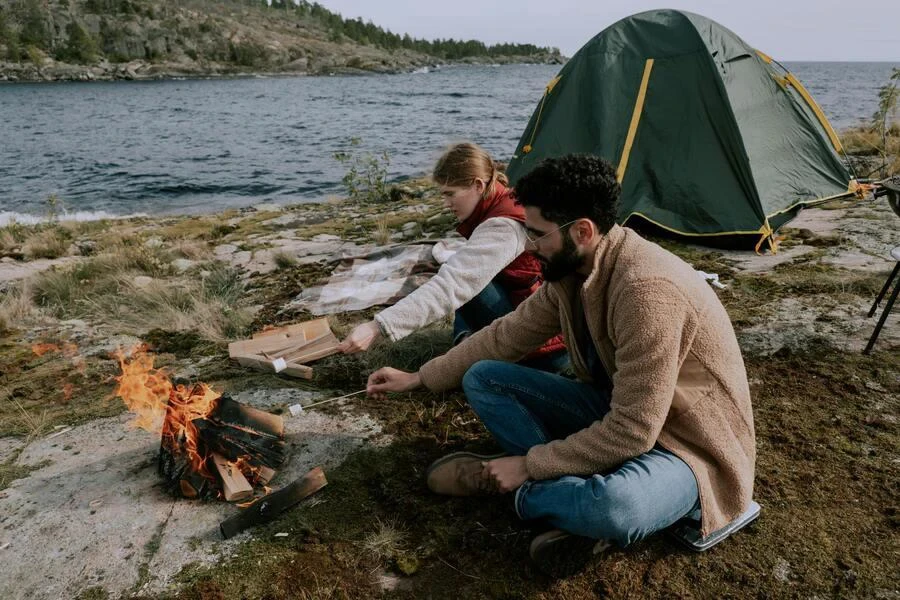
Whether the customer knows a lot about camping or is just starting out, knowing how to set up a tent is super important. It can make a big difference in how much they enjoy their time outdoors. Here are some tips you can share with them:
Find the best spot to camp
Picking the right spot for the tent is super important. Try to find a flat, dry place without any rocks or roots. It’s best if the spot is a bit higher up so water doesn’t collect there if it rains. Also, don’t set up in low areas that might get soggy or attract bugs.
Prepare the ground
Before putting up the tent, make sure to clean the ground. Get rid of stuff like twigs, stones, and dead leaves. This helps the camper sleep better and keeps the tent’s bottom safe. Use a little broom to sweep the area well. Put a tarp under the tent to protect it from wet ground and sharp things. The tarp should be a bit smaller than the tent so water doesn’t collect under it. Use small stakes or rocks to hold down the edges and keep the tent steady.
Assemble the tent
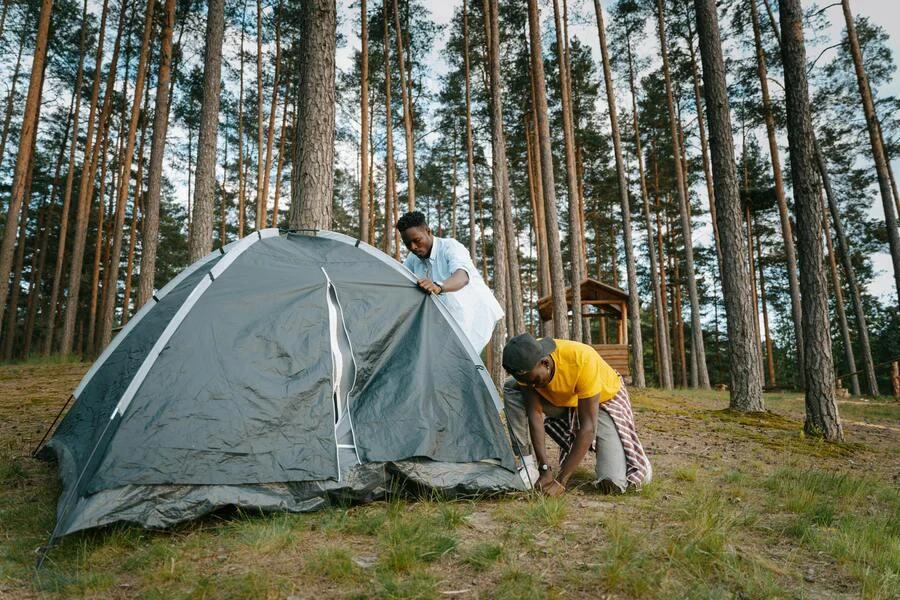
- Lay everything out: Before putting up the tent, the camper should spread out all the parts on the ground. This includes the poles, the rain cover, the stakes, and the tent itself. Doing this helps them see how it all fits together and makes sure they’ve got everything they need. It’s also a good way to check if anything’s missing and to get to know the setup steps.
- Put the poles together: The next thing to do is to connect the tent poles based on the instructions. Most new tents have poles that snap together. Campers should lay them out next to the tent to get ready for setup and check each pole to see if it’s damaged or worn out.
- Attach the tent body: Spread the tent out and put the poles in the right spots. This means threading them through sleeves or clipping them on. Once the poles are where they should be, lift the tent up to give it its shape. Then, make sure to fasten or clip everything else to keep it steady. This part can be a bit tricky, but it’s key to setting up your tent right.
- Secure the tent: Once the tent stands up, it’s time to stake the corners down. Pull each corner tight and stick a stake into the ground at a 45-degree angle. If the ground’s too hard, the camper can use a rock or hammer to drive the stakes in well. Make sure all corners have even tension so the tent doesn’t sag.
- Add the rainfly: If the tent has a rainfly, campers should throw it over the top and hook it to the poles or corners. Spread it out to give the best coverage and keep the rain out. Tighten all the attachments and adjust the tension so it doesn’t flap around in the wind.
Tweak the setup
After putting up the tent and rainfly, campers should walk around and look at how tight the guylines and stakes are. They need to make changes, if needed, to ensure the tent is tight and won’t fall over. Having the right tightness helps the tent stand up to wind and rain. If any lines are loose, tighten them up. If stakes aren’t holding, put them in again.
It’s super important to have good airflow to stop water from building up inside the tent. So, campers need to check that the tent’s air holes are open and the rainfly is set up to let air move through. This keeps the inside dry and comfy. Also, it’s a good idea to open windows or doors to get more air moving around.
Tips for a successful camping experience
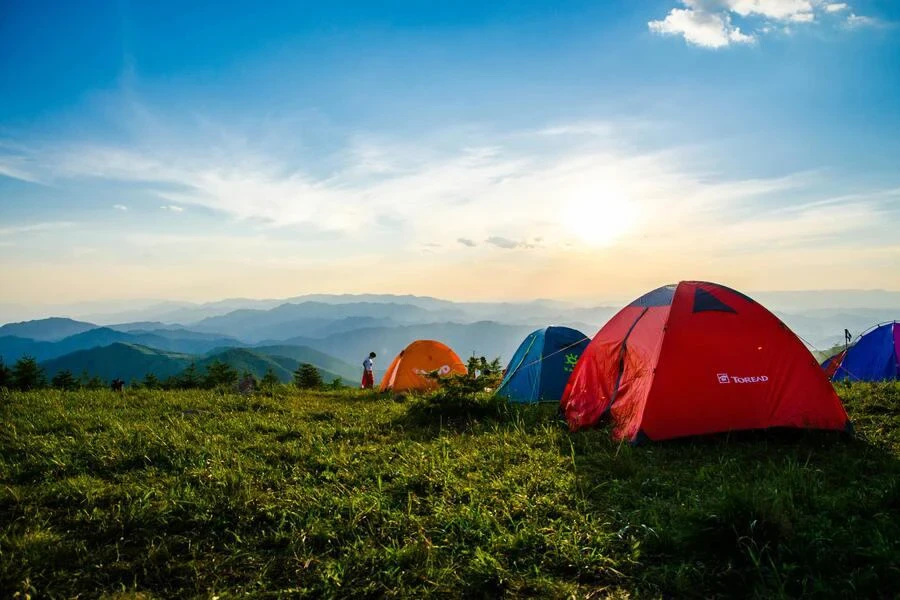
i) Organize the tent’s interior
Campers should set up their tent’s interiors to make the most of space and comfort. They can use gear lofts and pockets to keep small stuff and put heavy things like backpacks on the sides to keep it stable. Making specific spots for sleeping, cooking, and chilling helps keep things tidy. Hanging LED lights or lanterns lights up the tent inside, making it easier to find stuff when it’s dark and feel cozy. Choosing battery-powered or solar lights can help avoid the need for electrical connections.
ii) Bring comfort enhancements
Campers should bring a sleeping pad or inflatable mattress to improve their sleep. Getting good rest is key to having a great time camping. Packing pillows, blankets, and extra padding helps make the tent feel like home. Portable fans for when it’s hot, extra clothes for cold nights, and some snacks you love can make camping more enjoyable.
iii) Comply with safety precautions
To stay safe, campers can follow these basic camping rules:
- Keep a safe distance from wild animals and make sure food is safely stored.
- Drink enough water and shield themselves from the sun with the right clothes and sunscreen.
- Be ready for unexpected situations by having a first-aid kit and knowing basic first-aid steps.
- Get to know the local animals and plants to avoid possible dangers.
iv) Follow the “leave no trace” principles
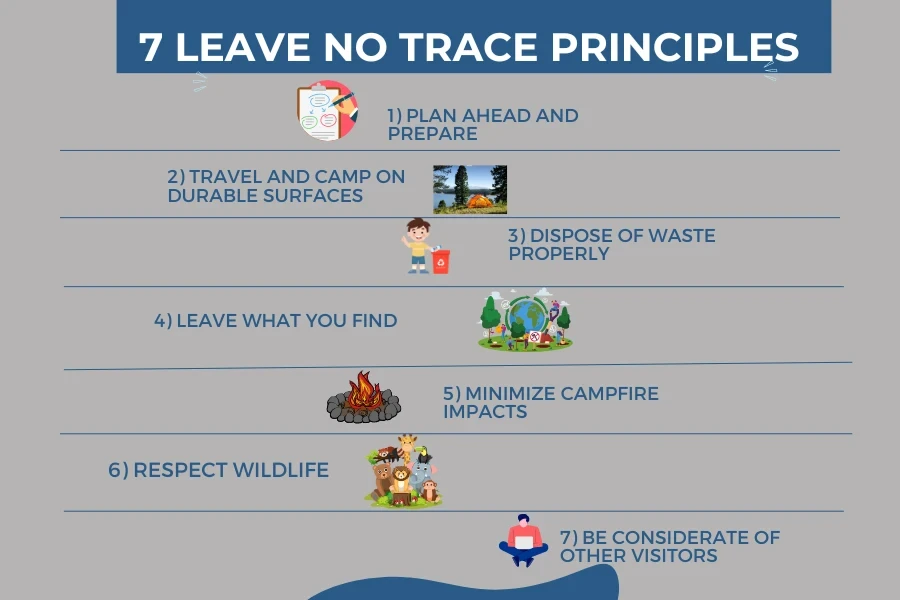
It is crucial for campers to protect nature. They should understand that their actions outside and in wild places have a big impact on plants, animals, people, and the whole ecosystem. So, campers should follow Leave No Trace principles, which include:
- Plan and prepare to know the campsite’s rules and special issues before they go
- Camp on tough ground, like campsites and paths that already exist
- Clean up properly by taking all the trash and extra food with them
- Don’t alter the natural environment or interfere with plants/buildings, and leave old things as they are
- Make less impact with campfires by using existing fire rings and keeping fires small
- Show respect to animals by watching them from far away and not giving them food
- Think of others by staying quiet and giving them space
Wrapping up
Knowing how to set up your tent for camping the right way is key to having a great time outdoors. Knowledgeable campers are more likely to want and purchase better camping gear. So, it’s super important for retailers to give customers not just great products but also helpful information and tips. The instructions and advice in this blog can help you to guide your customers towards a great experience in the outdoors, which in turn can make them happier and more loyal. This will not only lead to better sales, but also more reliable growth and success in the long run. So what’s to wait for? Help your customers gear up for great camping now!
